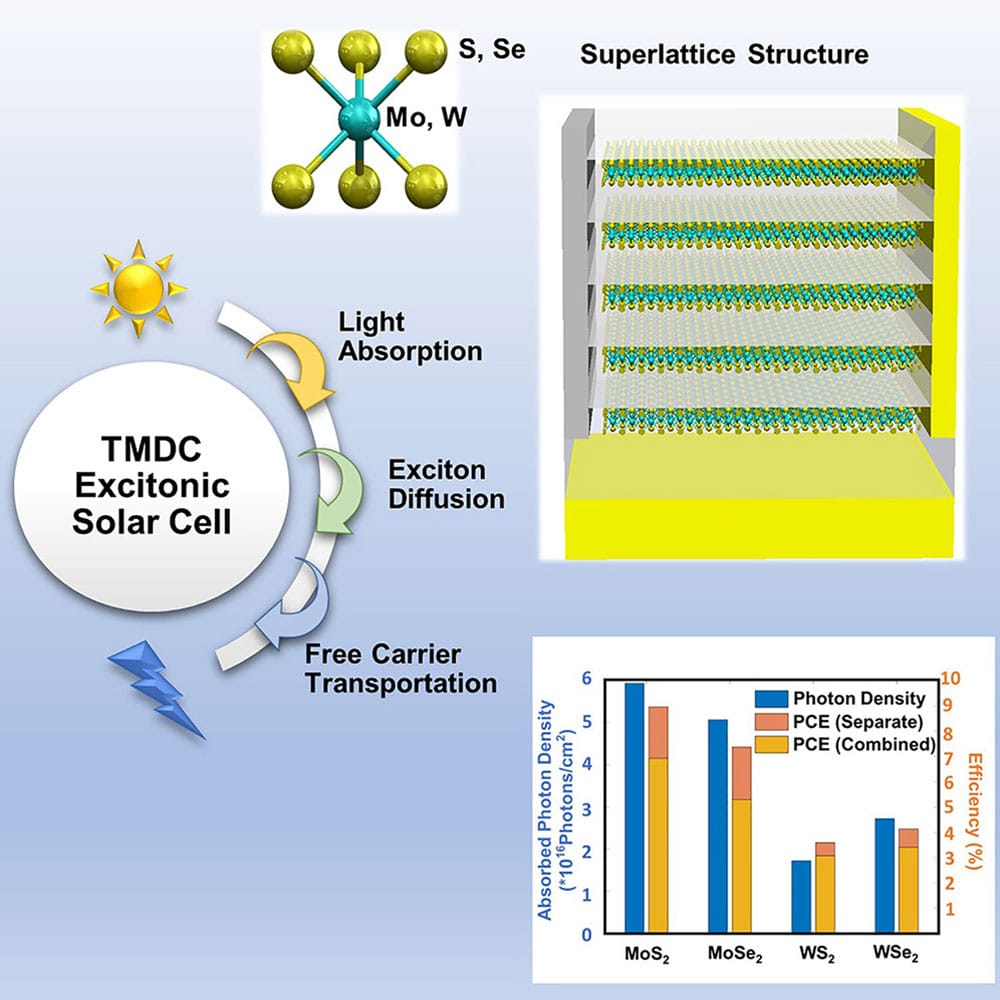When it comes to providing energy for space exploration and settlements, traditional solar cells made of silicon or gallium arsenide are still too heavy to be feasibly transported by rocket. To address this issue, researchers around the world are exploring a wide variety of lightweight alternatives, such as solar cells made of a thin layer of molybdenum selenide. These types of solar cells are classified into the broader category of 2D transition metal dichalcogenide (2D TMDC) solar cells.
Now, a research team from the University of Pennsylvania, Philadelphia, has proposed device design can take the efficiencies of 2D TMDC devices from 5%, as has already been demonstrated, to 12%.
While 2D TMDC solar cells tend to have much lower efficiency compared to silicon solar cells, they produce more electricity per weight (i.e., improved specific power). This is because a layer that is just 3 to 5 nanometers thick – over a thousand times thinner than a human hair – absorbs more sunlight than commercially available solar cells. Their extreme thinness earns them the label of “2D,” and they’re considered flat because they are only a few atoms thick.
“High specific power is actually one of the greatest goals of any space-based light harvesting or energy harvesting technology,” says lead author and Device advisory board member Deep Jariwala of the University of Pennsylvania. “This is not just important for satellites or space stations but also if you want real utility-scaled solar power in space. The number of solar cells you would have to ship up is so large that no space vehicles currently can take those kinds of materials up there in an economically viable way. So, really the solution is that you double up on lighter-weight cells, which give you much more specific power.”
The full potential of the solar cells has not yet been fully realized, so the team is now working to improve the efficiency of 2D TMDC solar cells even further by focusing on what is called ‘excitons.’ Excitons are produced when the solar cell absorbs sunlight, and their dominant presence is the reason why a 2D TMDC solar cell has such high solar absorption.
Electricity is produced by solar cells when the positively and negatively charged components of an exciton are funneled off to separate electrodes. By modeling the solar cells in this way, the team was able to devise a design with double the efficiency compared to what has already been demonstrated experimentally.

“The unique part about this device is its superlattice structure, which essentially means there are alternating layers of 2D TMDC separated by a spacer or non-semiconductor layer,” says Jariwala. “Spacing out the layers allows you to bounce light many, many times within the cell structure, even when the cell structure is extremely thin.”
“We were not expecting cells that are so thin to see a 12% value. Given that the current efficiencies are less than 5%, my hope is that in the next four to five years, people can actually demonstrate cells that are 10% and upwards in efficiency.”
Such performance opens potential applications in aerospace, remote sensing, and wearable electronics. The team next plans to achieve large, wafer-scale production for the proposed design.
“I think people are slowly coming to the realization that 2D TMDCs are excellent photovoltaic materials, though not for terrestrial applications, but for applications that are mobile – more flexible, like space-based applications,” says Jariwala. “The weight of 2D TMDC solar cells is 100 times less than silicon or gallium arsenide solar cells, so suddenly these cells become a very appealing technology.”
Journal reference:
- Zekun Hu, Da Lin, Jason Lynch, Kevin Xu, Deep Jariwala, Show footnotes. How good can 2D excitonic solar cells be? Device, 2023; DOI: 10.1016/j.device.2023.100003
